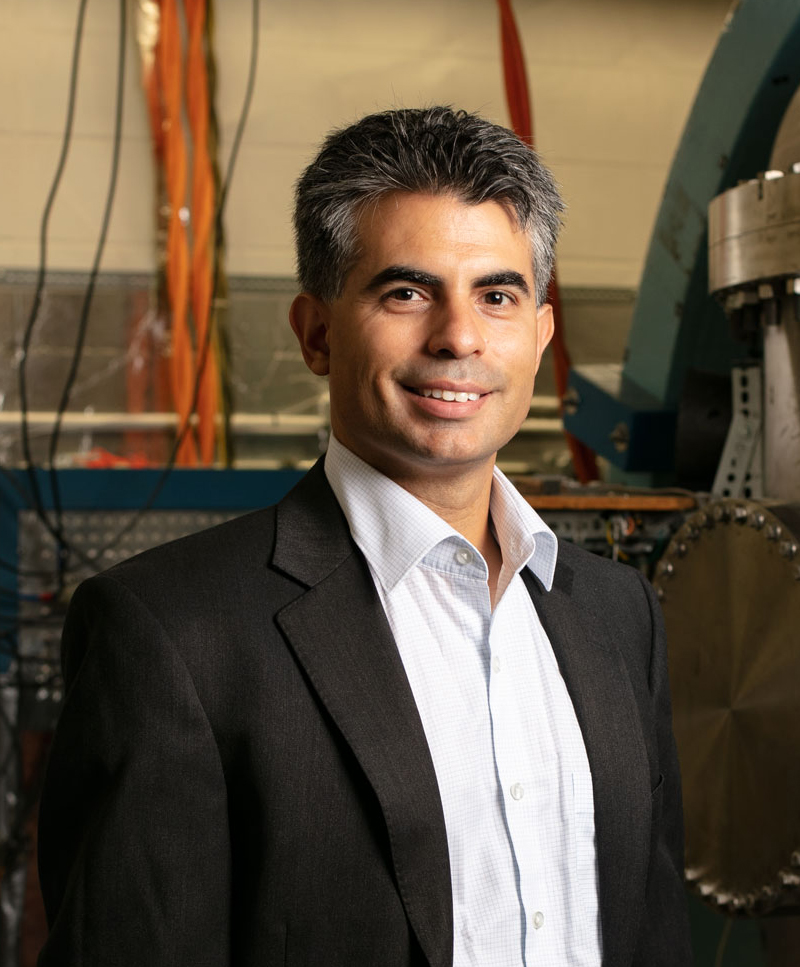General Atomics Trained Researcher Prof. Carlos Paz-Soldan to Receive the 2021 Thomas H. Stix Award
Prof. Paz-Soldan recognized by the American Physical Society for his research in the field of Plasma Physics

San Diego, July 30, 2021 – Prof. Carlos Paz-Soldan has been selected to receive the American Physical Society’s (APS’s) 2021 Thomas H. Stix Award for Outstanding Early Career Contributions to Plasma Physics Research. Prof. Paz-Soldan is the eighth person to receive the prestigious award, which is conferred annually by the APS in recognition of outstanding theoretical, experimental, computational, or technical contributions in plasma physics.
The APS citation recognizes his “groundbreaking contributions and scientific leadership in the understanding of non-axisymmetric magnetic fields and relativistic electrons in tokamak plasmas.”
Prof. Paz-Soldan arrived on-site at General Atomics in 2012 as a postdoctoral researcher. Working predominantly at the DIII-D tokamak facility, operated by General Atomics, Prof. Paz-Soldan studied how small adjustments to the tokamak magnetic field can be used to induce displacements in the plasma that control the loss of heat and help maintain stability of the plasma. The results of his experimental insights provided a means to more accurately predict application to future fusion power plants, as well as a basis to interpret behavior in present experiments.
“Although tokamak devices like DIII-D are designed to incredibly precise standards, unavoidable distortions in the magnetic field caused by differences of just several millimeters can have significant impacts on the fusion reactivity,” said Prof. Paz-Soldan. “The research I performed at DIII-D was focused on improving the distortion control of the plasma, and the results will help to make future reactors much more efficient.”
In a separate line of research, Prof. Paz-Soldan studied the phenomena associated with rapid shutdowns of fusion reactions, where relativistic “runaway” electrons often accelerate into an intense beam. His work helped explore the stability of this novel form of plasma, identifying ways in which these energetic electrons can be dissipated rapidly through natural processes in the runaway beam.
“I cannot think of a more deserving scientist than Carlos,” said Tony Taylor, Vice President of Magnetic Fusion Energy at General Atomics. “Carlos is an excellent researcher and a respected voice in the national and international fusion communities, and his findings have made significant contributions to the field of fusion energy. General Atomics was lucky to benefit from his passion for research and eagerness to mentor the next generation of fusion researchers. I congratulate him on this well-deserved honor.”
Prof. Paz-Soldan joined the Department of Applied Physics and Applied Mathematics at Columbia University’s Fu Foundation School of Engineering and Applied Science at the start of this year. Gerald Navratil, Edison Professor of Applied Physics at Columbia added, “Carlos is an outstanding plasma physicist well deserving of this early career recognition, and we were delighted when he chose to join us this year as a faculty colleague at Columbia University.”
Established in 2013, the Thomas H. Stix Award recognizes researchers who make significant contributions to the study of theoretical, experimental, computational, or technical physics in plasma physics early in their careers. As described by the APS, “areas of plasma physics covered by the Award include, but are not limited to, fundamental plasma physics, fusion plasmas, astrophysical or space plasmas, low-temperature plasmas, or high-energy-density plasmas.”
DIII-D is the largest magnetic fusion research facility in the U.S. and is operated as a national user facility by General Atomics for the U.S. Department of Energy’s Office of Science. Researchers come to DIII-D from across the globe to investigate a wide range of topics from fundamental plasma science to how future fusion power plants will work.
“Fusion science and research is a team sport,” added Prof. Paz-Soldan, “and this honor reflects the collaborative atmosphere fostered at DIII-D. So many people were involved in these projects, and we all worked together to focus on the big picture. With ITER on the horizon and accelerated private-sector investment, there has never been a more exciting time to work in fusion energy.”
The ITER experiment is an international collaboration of 35 nations that will demonstrate the feasibility of fusion energy. More than 70 percent complete, ITER anticipates generating its first plasmas in 2025.
About General Atomics:
Since the dawn of the atomic age, General Atomics innovations have advanced the state of the art across the full spectrum of science and technology – from nuclear energy and defense to medicine and high-performance computing. Behind a talented global team of scientists, engineers, and professionals, GA’s unique experience and capabilities continue to deliver safe, sustainable, economical, and innovative solutions to meet growing global demands. GA’s portfolio of innovative programs includes remotely piloted aircraft, such as the Predator and Reaper; the Electromagnetic Aircraft Launch System (EMALS) being installed on the new Ford-class aircraft carriers; and a variety of advanced manufacturing programs that are driving innovation in the nation’s Inertial Confinement Fusion program.
About the DIII-D National Fusion Facility:
DIII-D is the largest magnetic fusion research facility in the U.S. and has been the site of numerous pioneering contributions to the development of fusion energy science. DIII-D continues the drive toward practical fusion energy with critical research conducted in collaboration with more than 600 scientists representing over 100 institutions worldwide. For more information, visit www.ga.com/diii-d.
For more information contact:
Zabrina Johal
Director of Strategic Development
858-455-4004
Zabrina.Johal@ga.com